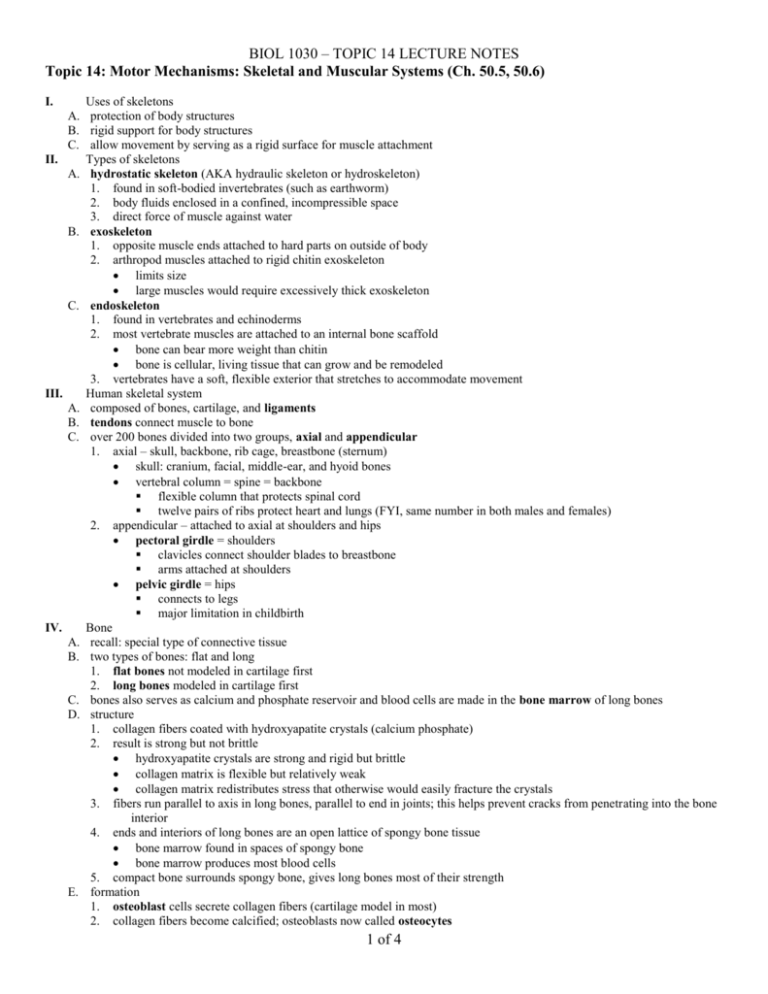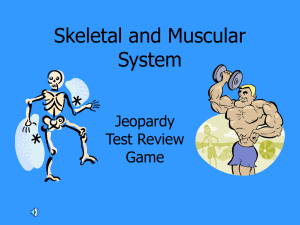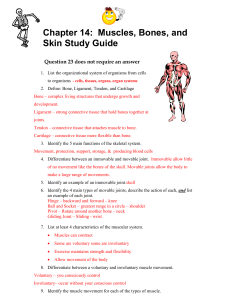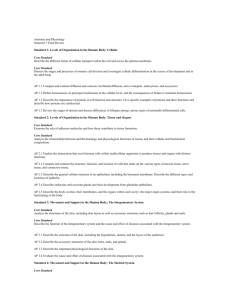topic14
advertisement

BIOL 1030 – TOPIC 14 LECTURE NOTES Topic 14: Motor Mechanisms: Skeletal and Muscular Systems (Ch. 50.5, 50.6) I. Uses of skeletons A. protection of body structures B. rigid support for body structures C. allow movement by serving as a rigid surface for muscle attachment II. Types of skeletons A. hydrostatic skeleton (AKA hydraulic skeleton or hydroskeleton) 1. found in soft-bodied invertebrates (such as earthworm) 2. body fluids enclosed in a confined, incompressible space 3. direct force of muscle against water B. exoskeleton 1. opposite muscle ends attached to hard parts on outside of body 2. arthropod muscles attached to rigid chitin exoskeleton limits size large muscles would require excessively thick exoskeleton C. endoskeleton 1. found in vertebrates and echinoderms 2. most vertebrate muscles are attached to an internal bone scaffold bone can bear more weight than chitin bone is cellular, living tissue that can grow and be remodeled 3. vertebrates have a soft, flexible exterior that stretches to accommodate movement III. Human skeletal system A. composed of bones, cartilage, and ligaments B. tendons connect muscle to bone C. over 200 bones divided into two groups, axial and appendicular 1. axial – skull, backbone, rib cage, breastbone (sternum) skull: cranium, facial, middle-ear, and hyoid bones vertebral column = spine = backbone flexible column that protects spinal cord twelve pairs of ribs protect heart and lungs (FYI, same number in both males and females) 2. appendicular – attached to axial at shoulders and hips pectoral girdle = shoulders clavicles connect shoulder blades to breastbone arms attached at shoulders pelvic girdle = hips connects to legs major limitation in childbirth IV. Bone A. recall: special type of connective tissue B. two types of bones: flat and long 1. flat bones not modeled in cartilage first 2. long bones modeled in cartilage first C. bones also serves as calcium and phosphate reservoir and blood cells are made in the bone marrow of long bones D. structure 1. collagen fibers coated with hydroxyapatite crystals (calcium phosphate) 2. result is strong but not brittle hydroxyapatite crystals are strong and rigid but brittle collagen matrix is flexible but relatively weak collagen matrix redistributes stress that otherwise would easily fracture the crystals 3. fibers run parallel to axis in long bones, parallel to end in joints; this helps prevent cracks from penetrating into the bone interior 4. ends and interiors of long bones are an open lattice of spongy bone tissue bone marrow found in spaces of spongy bone bone marrow produces most blood cells 5. compact bone surrounds spongy bone, gives long bones most of their strength E. formation 1. osteoblast cells secrete collagen fibers (cartilage model in most) 2. collagen fibers become calcified; osteoblasts now called osteocytes 1 of 4 BIOL 1030 – TOPIC 14 LECTURE NOTES 3. 4. F. V. A. B. C. VI. A. B. C. D. VII. osteocytes are encased in lacunae Haversian system – basic unit of structure for bone Haversian canals – narrow channels that run parallel to length of the bone; they interconnect, and they carry blood vessels and nerve cells lamellae – thin, concentric layers of bone surrounding the canals canaliculi – openings in bone between osteocytes and the canals modifications 1. cartilage remains for a while at the neck of long bones, allows for continued growth until completely replaced (usually in late teens) 2. articular cartilage remains at ends of bones, involved in joints 3. osteoclasts can dissolve bone, allowing remodeling of bone 4. new bone is formed along lines of stress, when possible joints: where bones come together sutures 1. nearly immovable, joined by connective tissue 2. some movement in early development (fontanels of infants) 3. main example: cranial bones cartilaginous joints 1. slightly movable; bones bridged entirely by cartilage 2. main example: vertebral bones in the spine pads of cartilage are intervertebral disks efficient cushioning shock absorbers that allow some flexibility synovial joints 1. freely movable joints 2. ends of bones in synovial capsule, a fibrous structure strengthened by ligaments and filled with lubricating fluid 3. types include ball-and-socket, hinged 4. rheumatoid arthritis: degeneration of synovial joint connective tissue tendons: where bones and muscles come together tendons are straps of dense regular connective tissue muscle origin attaches to stationary base muscle insertion attaches to movable bone freely moving joints move by opposing sets of muscles 1. flexors decrease joint angle (move bones closer together) 2. extensors increase joint angle (move bones further apart) Muscular System specialized cells devoted produce body movement by contraction achieve contraction by ATP-consuming activity shifting relative positions of actin and myosin filaments muscles as organs include the tissues (blood vessels, etc.) that support the muscle tissue three types in vertebrates, based on muscle tissue type: smooth, skeletal, and cardiac smooth muscle review 1. tissue sheets with long, spindle-shaped, mononuclear cells 2. individual myofibrils of actin and myosin not specifically aligned 3. blood vessel and iris muscles contract with specific stimulation 4. gut muscles contract spontaneously 5. specialized for slow, maintained contraction with minimal energy use F. skeletal muscle review 1. very long, multinucleate cells called muscle fibers that run in parallel 2. fibers made of myofibrils; ordered structure produces striated appearance 3. specialized for rapid contraction with large force 4. under voluntary control by interactions with nerve tissue G. cardiac muscle review 1. composed of striated fibers, orientation different than skeletal fibers chains of single, branching cells with individual nuclei electrically coupled to neighbors by gap junctions at intercalated discs 2. lattice structure critical to heart muscle function contraction initiated at one location spreads throughout myocardium via electrical impulses 3. heart works as well-ordered system to propel blood through body A. B. C. D. E. 2 of 4 BIOL 1030 – TOPIC 14 LECTURE NOTES VIII. A. B. C. D. E. F. IX. A. B. X. myofilament structure long chains of actin and myosin proteins also contains troponin and tropomyosin proteins actin 1. polymer makes up thin filaments that are strings of actin "beads" 2. two filaments wind around each other to form a long, twisting double helix myosin 1. spontaneous polymerization to make up thick filaments 2. myosin molecule is ten times longer than actin 3. each molecule is a twisted pair of polypeptides one end is rod-shaped; other end has two globular "heads" myosin heads can form cross-bridges with actin banding pattern 1. A bands: dark bands of stacked thick (myosin) filaments 2. I bands: light bands of stacked thin (actin) filaments 3. Z lines: dark lines of dense material in the center of I bands; form anchors for the thin filaments 4. thin filaments intercalate into thick filaments 5. H bands: lighter region in center of A band, where thin filaments are not present 6. sliding filament mechanism of contraction: myosin "pulls" actin in, reducing size of H bands and I bands sarcomere: repeating organizational unit from Z line to Z line: Z-I-A-H-A-I-Z muscle contraction mechanisms and control cross-bridge cycle in muscle contraction 1. myosin heads act as ATPases, "cocking" heads 2. cocked heads form cross-bridges with actin 3. after binding, head changes shape, pulling thin filament toward the center of the sarcomere (the power stroke) 4. myosin head binds to new ATP, releasing from actin 5. cycle repeats, and myosin heads "walk" along actin filaments 6. absence of ATP = cross-bridges frozen in place (example: rigor mortis) 7. Ca++ involved in regulating accessibility of actin filament, thus regulating relaxation vs. contraction how nerves signal muscles to contract 1. neuromuscular junction formed where nerve fiber embeds in muscle 2. motor neuron releases the neurotransmitter acetylcholine (ACh) at junction 3. ACh stimulates electrochemical impulse that travels along membrane of muscle fiber 4. impulse opens Ca++ channels on muscle membranes 5. effect of opening Ca++ channels ER of muscle called sarcoplasmic reticulum (SR) SR wraps around myofibril like a sleeve Ca++ channels embedded in SR ATP-driven calcium pump actively concentrates Ca ++ into SR spaces Ca++ channels in SR open with impulse, flood sarcoplasm around myofibrils with Ca++ tropomyosin covers myosin binding site on actin in resting muscle troponin bound to tropomyosin troponin + Ca++ moves tropomyosin out of the way so that myosin can bind to actin MOVIE of complete cycle - http://www.sci.sdsu.edu/movies/actin_myosin_gif.html 6. contraction ends when Ca++ is pumped back into SR by active transport 7. thus, Ca++ is responsible for excitation-contraction coupling (got milk?) contraction of skeletal muscles A. contraction force dependent on summation and recruitment B. summation 1. result of repetitive firing of motor neuron 2. with increased stimulation rate: Ca++ concentration increases total contraction force of muscle increases individual contractions become smooth, forceful contraction 3. tetanus: maximum contraction value (smooth, sustained) 4. summation factors muscle fibers must be able to respond to high Ca ++ levels neuron firing frequency must be quicker than individual muscle twitch (how quickly muscle will contract and relax) 3 of 4 BIOL 1030 – TOPIC 14 LECTURE NOTES C. recruitment 1. each skeletal muscle fiber innervated by only one motor neuron 2. one motor neuron usually innervates many muscle fibers 3. motor unit: set of muscle fibers controlled by one neuron motor unit with few fibers requires lowest level of activation, results in smaller contractile force to increase force, more and larger motor units are activated, a process called recruitment, that produces a stronger contraction XI. contraction of cardiac muscle A. impulse not initiated from motor neurons (may be regulated, though) B. instead, initiated at pacemaker C. no summation = no tetanus (must keep up contraction/relaxation cycle) D. two functional myocardia 1. one for the two atria that receive blood 2. one for the two ventricles that pump blood to the lungs and body 3. slowdown of signal between the two myocardia separates them into two units that contact at different times XII. contraction of smooth muscle A. actin and myosin not organized into sarcomeres B. myosin molecules attached to dense bodies or muscle membrane C. no SR 1. Ca++ comes from extracellular space 2. Ca++ channels opened by autonomic neurotransmitter activation 3. Ca++ in sarcoplasm binds to calmodulin 4. Ca++-calmodulin activates myosin light chain kinase (MLCK) 5. MLCK phosphorylates myosin heads, activating them 4 of 4








